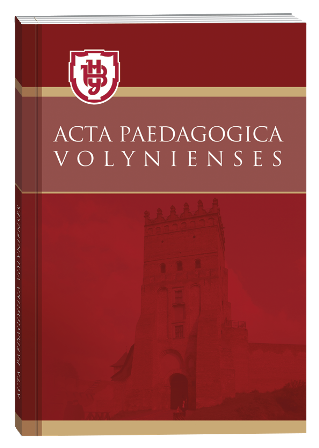ESSENCE AND STRUCTURE OF COMMUNICATION OF FUTURE MUSIC TEACHERS
DOI:
https://doi.org/10.32782/apv/2023.3.8Keywords:
functions of communication, types of communication, requirements for the social and professional position of a music teacher, types of communication, communication styles.Abstract
The article examines the essence and structure of communication of a future music teacher, outlines the concept of "teacher communication" as a specific form of business interpersonal communication, which has its own characteristic features, and at the same time is subject to general psychological patterns inherent in communication as a form of interpersonal interaction; includes communicative, interactive and perceptive components. It is noted that the purpose of communication between a music teacher and a student is both the transfer of social and professional experience (knowledge, abilities, skills), and the exchange of personal meanings related to the objects being studied and life in general. Communication itself contributes to the emergence and formation, formation and development of new properties and qualities of individuality of both students and teachers. Only in the process of communication can the general and professional culture of future teachers, the system of their life goals and values, moral norms and principles be successfully formed. Emphasis is placed on the fact that the content of the communication of students of the specialty «014 Secondary Education (Musical Art)» is, first of all, the exchange of information, the purposeful organization of mutual understanding and relationships with students by university teachers using various communication tools, which will be key in the further work of future music teachers art Therefore, the main functions of the interaction of the subjects of the pedagogical process during optimal communication between the music teacher and the students are: constructive, organizational, communicative-stimulating, informationaleducational, emotional-corrective, control-evaluative. And depending on the goals, tasks and nature of the joint activity of the teacher and students, their organization and the resulting system of relationships, several types of communication are distinguished. In particular, it is possible to distinguish: socially-oriented, group subject-oriented, personal-oriented, psychological relationships. An important emphasis can be considered that the social and professional position of the music teacher is also reflected in his communication style, which is understood as the individual-typological features of interaction with students. Select five different styles of communication of music teachers: the style of communication between the teacher and students based on enthusiasm for joint creative activity; communication style taking into account friendly affection; communication style based on a clearly and consistently established distance; communication style based on intimidating students; communication style, taking into account flirting with schoolchildren. From the positions of the most characteristic manifestations in the classification of pedagogical communication styles, such varieties as autocratic, authoritarian, democratic, free-liberal, liberal and inconsistent are distinguished.
References
Бацевич Ф. С. Основи комунікативної лінгвістики. Київ : ВЦ «Академія», 2004. 344 с.
Волкова Н. П. Професійно-педагогічна комунікація : навч. посіб. Київ : ВЦ «Академія», 2006. 256 с.
Гарькавець С. А. Конфлікти в освітньому середовищі: діагностика та практика вирішення : навч.-метод. посіб. Харків : Друкарня Мадрид, 2020. 91 с.
Долинська Л. В., Уварова Ю. В. Формування стильових особливостей педагогічного спілкування у майбутніх вчителів. Київ, 2005.
Орбан-Лембрик Л. Е. Психологія професійної комунікації : монографія. Чернівці : Книги-ХХІ, 2009. 528 с.
Орбан-Лембрик Л. Е. Спілкування як соціально-психологічний феномен. Філософія, соціологія, психологія. Івано-Франківськ, 2003. Вип. 8. Ч. 2. С. 109–114.
Почепцов Г. Теорія комунікації. Київ : Видавничий центр «Київський університет», 1999. 308 с.
Стилі педагогічного спілкування. URL: https://pidru4niki.com/17340501/pedagogika/stili_pedagogichnogo_ spilkuvannya (дата звернення: 23.06.2023).
Теслюк В. М. Психологічні засади формування індивідуального стилю професійно-педагогічного спілкування у майбутніх викладачів : дис. … кадн. псих. наук : 19.00.07. Київ, 2007. 250 с.
Яшенкова О. В. Основи теорії мовної комунікації : навч. посібн. Київ : ВЦ «Академія», 2010. 312 с.
Яремчук С. В. Самоактуалізація майбутнього педагога як суб’єкта навчально-професійної діяльності. Нові виміри сучасного світу : матеріали І міжн. наук.-практ. інтернет-конф. Т. 1. Ч. 2. Мелітополь, 2005. С. 17–20.







